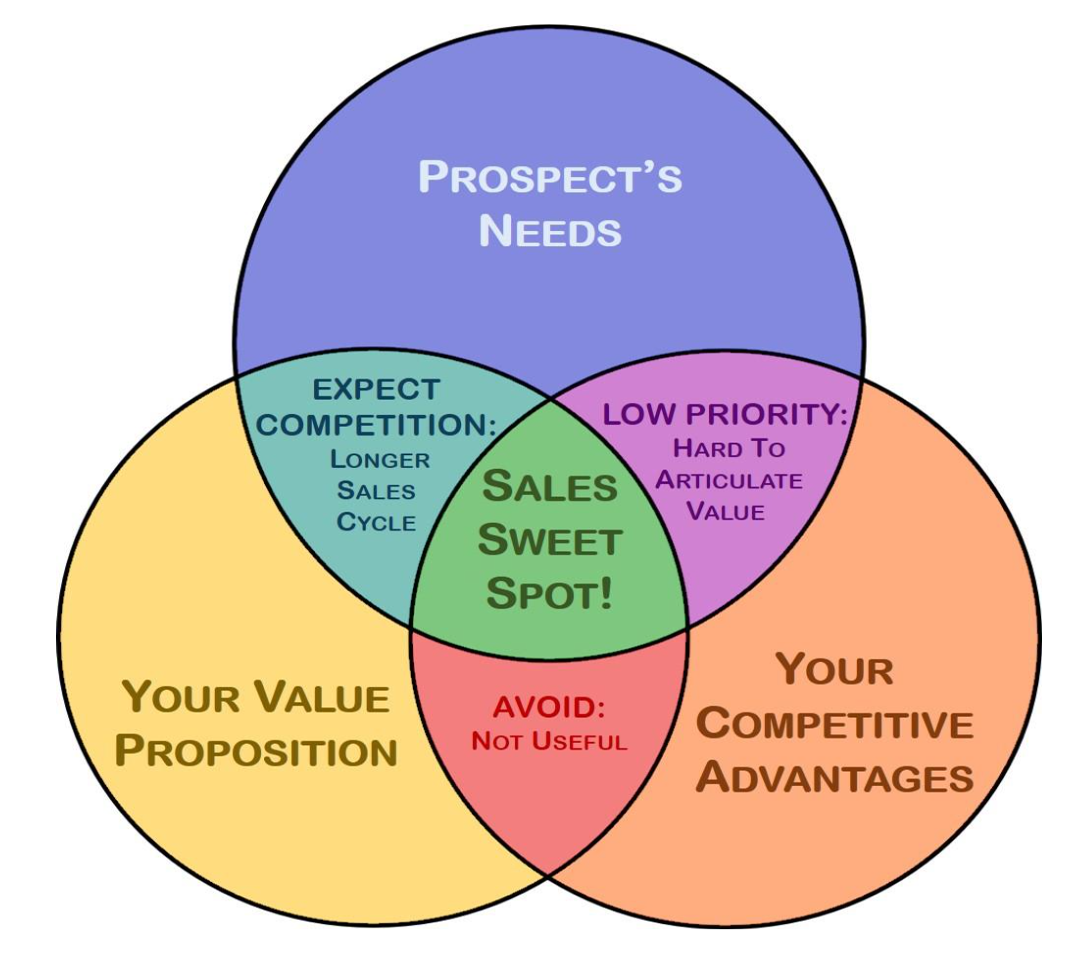
09 Jun THE SWEET SPOT TO PROSPECT
I am often asked by salespeople to explain the best method of identifying the highest-potential prospects to target. “How can I find these prime prospects, so that I do not waste my time on companies that are not going to buy from me this year?”
There is no easy answer to this, but there is a strategy that you can use to increase your chances of finding them. And, it is not as difficult as it may seem. The clue is that you need to decrease the universe of all prospects to just those that have needs that are the best fit for your company and product.
Let’s consider a fishing analogy: The objective is to catch enough fish for a meal today. Now, you need to answer these questions: What kind of fish do you want to catch? Where do you go? Is it someplace near or far? Shall you fish from shore or a boat? Have you fished there before? Were you successful? What bait shall you use? What is your spending budget? If you can answer these questions the answer to where to fish should be apparent and your chances of catching a fish today are higher. Success does not come from going to a random body of water, standing on the shore, casting aimlessly, with any kind of bait you can find and then expecting to catch a fish that day. That applies to sales as well.
To find the best prospects you need to determine:
- What is your value proposition?
- What are your competitive strengths?
- Which prospects are likely to have needs that you can fulfill?Your value proposition is the unique positive business value that your solution, product, or service brings to the marketplace. Your competitive strengths are the advantages you have over the other suppliers (and “do nothing”) and can include their weaknesses. There can be overlaps with the value proposition. The prospect’s needs are sometimes disclosed, but often need to be found during your discovery process.Let’s review the diagram below that consists of three intersecting circles for each of these questions.
- The orange circle represents your competitive strengths
- The blue circle represents your prospect’s needs
- The yellow circle represents your value proposition
The red area includes prospects that do not have needs that match your value proposition and strengths. They are a waste of time and should be avoided.
The purple area includes prospects that have needs that are in your competitive strengths, but do not match your value proposition. That can happen if the prospect requires a low price, for example, which may be one of your competitive advantages, but they may not see value from your solutions. These prospects should receive a low priority, unless your strategy is to be the low-cost provider in the marketplace, in this example.
The teal area includes prospects that have needs that match your proposition value, but are outside your competitive strength. These prospects should be targeted, with the realization that the deals will be very competitive and that you will need to work harder to establish greater trust with the buyer to be chosen.
The green area in the middle is your “Sweet Spot.” This is where the prospect’s needs, your value proposition, and competitive strengths are aligned. These are the prospects that you want to seek and sell to, as you will have an advantage and your probability of closing the sale is greater. Among their needs are some that match with the value you bring to the prospect and also fit with your competitive strengths. These are the unique selling propositions that you need to validate during the discovery process and to emphasize during your presentation.
The “Sweet Spot” is more desirable than the “Ideal customer profile”, which describes the type of prospect, from amongst the universe, that is the best fit for your product or service based on functionality or vertical market characteristics. A company could be “ideal” if it looks like it meets the criteria; however, that does not mean it is a prospect that has needs for which you can provide the best solution.
Finding prospects in the Sweet Spot requires you to master your value proposition and competitive strengths and then identify those companies that would likely need a solution that your company offers. Next, make a list of all of the titles that would normally purchase from you and then use Linkedin.com, Hoovers or another source to find the person’s names, telephone numbers, and email addresses. You can approach the individuals through cold-calling, direct-mail or LinkedIn.com, or all of the above.
By initiating conversations that lead to questioning you will discover their needs and then can assess which area the prospect fits in. Once you have contacted all of the targeted companies you will prioritize your calls to follow-up with the companies in the green bucket first, then the teal and purple. While questioning the prospects you will also determine their sense of urgency and the name of their decision-maker.
If you do not have enough prospects in the green, teal and purple areas you need to do a better job of understanding your product’s value and strengths to then identify the companies that would benefit the most. Restart and try again.
I am confident that if you follow this easy method you will find more prospects that are in the Sweet Spot and increase your sales – this year!